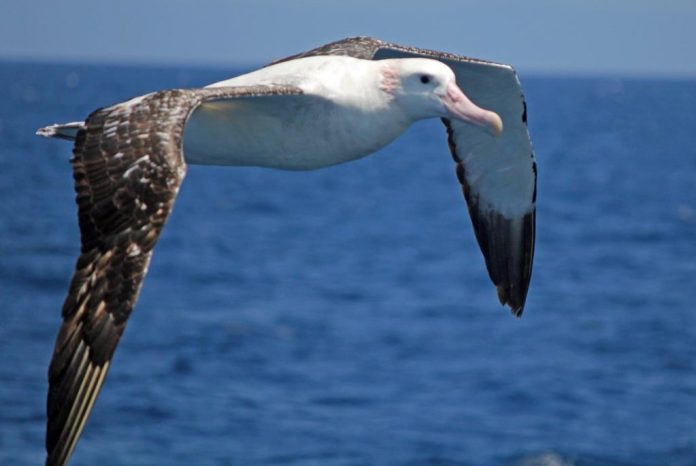Wandering Albatross (Diornedea exulans) is the largest flying bird with a wingspan of nearly three-and-a-half meters. True to its name it wanders around the globe in southern latitudes, frequently following ships. His flight is an effortless and graceful, seemingly never-ending glide punctuated by occasional beats only on calmer days, traversing the ocean in the manner typical of all albatrosses. As it drops low, the bird turns into the wind to gain lift but a little forward movement.
Wandering Albatross reaching sufficient height of 5-20 meters – it turns downwind, sweeping away over the sea until forced to turn into the wind. For rest, the bird sits on the sea and feeds there, eating mainly squid and cuttlefish, augmented by crustaceans, fish, and offal from boats. Wandering Albatrosses may live for more than 40 years and rarely breed until nine years old.
Each breeding cycle lasts almost 11 months and so most adults (80 percent) nest only every second year. The birds arrive at their breeding colonies, on subantarctic islands, in September and begin elaborate courtship rituals of bowing, bill-fencing with loud clappering, and dancing with wings outstretched; at the peak of the dance, both partners throw the head back with beak pointing skywards and bray loudly.
From one to six or more pairs of birds of diverse ages take part in these ceremonies which can form pair bonds for life. Wandering Albatross eggs are laid in mid-November, the female returning to the nest site of previous years if successful. The male takes the greater share of incubation and may sit for 38 days in a shift. Usually, the sexes change every two to three weeks, losing about 17 percent of their weight at a sitting.
Metabolic rates differ between the sexes, the larger male having the lower rate so that he can sit for longer without losing any more weight. As soon as a sitting bird is relieved it flies straight out to sea to feed and regain the weight. On land, it is ungainly, able only to waddle slowly with its neck held low in line with its swaying body.
So the albatross needs a bare ledge or hilltop with an up-draught from which it can take off directly by just spreading its wings. Chicks take three days to break out of the egg at hatching, and far longer to fledged – 270 to 280 days; next year’s adults have sometimes returned to breed before the young have left the nest.
Parents feed their chicks through the whole winter, daily for the first 20 days and then progressively less often but bringing larger amounts of food. It is an energetically demanding period for adults, and chicks of parents whose shifts in incubation were not evenly shared – predominantly where the brunt fell on the female-have less chance of survival. or else mortality at nests is low, involving only the occasional trampling of an egg or its predation by skuas.
By the next September, the young bird is finally fledged and set out for the ocean. After its departure, the parents also wander off and somewhere at sea undergo their moult. The other names of this bird are Snowy Albatross and White-winged Albatross.
Related Reading: Black-browed Albatross (Thalassarche melanophris)
Wandering Albatross length is up to 1350 mm; wingspan up to 3250 mm. Both sexes are similar; male slightly larger. From a distance completely white but at close range fine brown edges of body feathers give a scalloped effect, strongest in females. Back of the wing changes over ten years from black with two white spots to heavy blotches, then to white.
The underwing is white except for the black tip and edges with the whitetail. Some adults have a flush of pink around-ear and side of the neck, and their eyes are brown with the pink bill. Feet, toes, and webs are fleshy white.
The immature bird is black except for white face and underwing, but whiten rapidly in first three years and then more slowly. Brown breast band and grey plumage with wavy lines often rer11ain up to the seventh year. The black band at the tip of the tail, with the bill and feet, is grayish. The change to adult plumage is gradual and takes about I0 years. The downy young is white-downed.
Wandering Albatross call is hoarse braying whistles in the dancing display; coughing grunts when fighting over food. The bird is clappering the bill during courtship. Chicks pipe, whistle, and gurgle. The bird is mostly silent in flight.
Nesting begins in early September; single brooded. Nest a large muddy bowl on the ground, reinforced with plant material. Egg: one; white, speckled with red-brown; oblong-oval, about 131 x 78 mm. The incubation period is 9-11 weeks, for both sexes. The juvenile fledges in 270-280 days. This bird is found throughout the southern oceans.
Found in southern Australian waters north to Perth in the west and southernmost islands of Great Barrier Reef in the east; greatest numbers off southeastern Australia in winter. Wandering Albatross breeds on subantarctic islands, including Macquarie Island. Two races are both reaching Australia: one small and breeding on north subantarctic islands; the other large and breeding on south subantarctic islands.
Read More – Montagu’s Harrier









